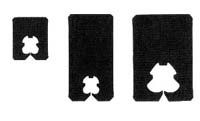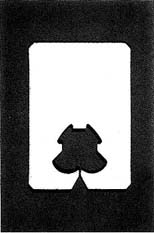

The tussle between the ingredients of a loaf of
bread and its wrapping is naked to the eye. Advertisers clearly
display their seductive acumen all over the bag's skin. It is
fair game to print sheaves of nineteenth-century wheat on its
surface for it is reassuring to see through the caper for we are
all familiar with its true pedigree. The eater must be reassured
that the $.04 worth of powdered grain is worth the $1.69 we pay,
despite the fact that there is a frightful discrepancy between
the grain's worth and its cost. Bread is forgiving and the
interlopers know it. They place strategies of marketing between
wheat and the eater on the understanding that the word "bread"
will seal the possible rift that they may induce.
Established bread rules exist which take a
lifetime to learn and are invisible to those not conversant with
American bread lineage. Apart from the names and sizes of loves
there are minute indicators that are Braille-ridden in breads.
When choosing a loaf, the hand clutches and the side fingers
automatically grip the loaf's back. Bread is apparently squeezed
as if it were a ripe fruit, but actually it is a test to verify
the existence of the imaginary exoskeleton. Modern bread is
always neutered and deboned before it is eaten. We know from
bread history that bread bones did exist, making us now hesitate
before swallowing.
Bread and its package are a sham. The
marginally acceptable eating of it and the sometimes reusable
plastic sock-bag barely make up for the half-truths that
surround the entire pantheon of bread manufacture. Is there any
part of the stuff that can tell a straight tale without
forfeiting the dignity of its past? Bread buyers have always had
a distrust of the miller and his cohorts. The miller was forever
putting things into flour, perhaps a little chalk, to stretch
the profits. Today, bags of vitamins are exchanged for chalk and
bran dumping is practiced. The wheat-for-bread barter seems to
be as distant as it ever was.
However, beyond the act of eating there now
exists a new grain of redemption. Pinched around the throat of
each bag is the bread tag. Like all tags or ties it is perceived
to have a measure of respectability. The modern bread tag acts
as a sentinel surveying the absurdities of current salesmanship.
Gone from the shelves is the wire twist tie, whose paper shell -
after too much fingering, twisting and retwisting - was reduced
to a matted paper ball hindered by dampness and the hunger of
buttered fingers.
The tag, a flat plastic section the size of a
quarter, press-fits into the untidy folds of the neck of the bag
and grips onto it for dear life. The plastic closure tag sets
itself apart from the nonsense of bread selling. Its flatness,
indelibility and practical honesty is antithetical to the
charade of salesmanship and confusion of eating. If it were to
get stuck in the throat, its plastic fangs might turn outwards
and latch onto the epiglottis. By all reason, the tag should not
be anywhere near a loaf of bread. It is dangerous and
unwanted.
Russians watching the film Dirty Harry probably
think the shoot-out in the supermarket is not as interesting as
the thirty types of bread on the shelf. They might prefer to
observe the events which occur at the edge of the screen. The
bread tag thus assumes the role of voyeur.
The manufacture of objects has fairly uneasy
history. In a general attack against mechanical manufacture
Ruskin blasted the possibility for any sort of artful
expressiveness in the mechanical process. In his view an object
was viable only if the entire weight of the maker could be
counted through the thousands of blows wrought on a piece of
iron. A wrought iron leaf speaks of the life within only when it
has within it the multitude of hurts and caresses. A melt-metal
cast-iron leaf has, by comparison, a manufactured nothingness.
It's gone, dead before working, and is discounted as the disease
and decay of the love of objects.
Within the past one hundred years attitudes
toward manufacturing have changed radically. The honesty of
metal beating has been relegated to cuteness. That venue for
creative expression has evaporated, its linneage patented by
dogmatic rural expressionists who craft things for the sake of
materials alone. The manufactured object, such as the aeroplane,
was deified in the 1930's for the vitality of its design and the
process of mass production in the factory. Since then the glory
of manufacture has been usurped by machines that design machines
that make machines for us to use. In this divorced state, the
maker has become usurped and his works trivialized. He has been
pushed towards an indefinite state of unmotivated
redundancy.
Boredom is the final pass in every process.
When everything is worked out and the activity is no longer a
struggle, the maker's frame slumps forward. Boredom is vital to
making. However, boredom itself can not improve the product, it
can only lay waste its previous vitality and fortitude. In the
insistent repetitiveness of mass production, the skill required
to stamp out a metal sheet is very quickly forgotten. Whilst the
sheets of metal fly past the operator, he is lulled into a
daydream and through projective imagination he becomes his own
master again. As long as there are moments of reverted tabula
rasa, there is hope that the maker can empty his soul once more
into the object.
A bread package maker, for example, works out
and over-choreographs the sheaves of wheat on the loaf package.
It is a job which is riddled with justifications: "This is why
it looks like that and that is why it looks like this!" But this
is constipated death to intelligence for it is too reasonable.
Every variable is considered by the clever designer and,
accordingly, the recipient of the object is put in a perpetual
straight jacket where every move has been masticated and there
is nothing left to invent. In this instance the overly conscious
designer prefigures every move and leaves one smothered in
pregurgitated excellence. There is another sort of designer
whose marginal task it is to figure out the bread tag.
At first glance bread tags appear perfectly
sensible. The plastic has printed upon it the curriculum vitae
of the bread within: how much it costs, when it is going to be
stale, who made it, and where. The tag also doubles as something
to hold when the bread bag is pressed between the fangs of the
snap, making them open askance and letting the folds of the bag
crowd into the hole provided. The hole may have teeth set into
the sides to prevent the oily bag of bread from slipping
through. Each tag design has marginally different quirks. In
some there are no teeth, in others there might be a pronounced
entry slot. Each design is slightly dissimilar.
If a row of bread tags are balanced on their
entry holes they become figurative. A city comes into existence
and it is populated by blocks of white glassine masonry accessed
through a lower passage. Sometimes a room is smooth and rounded.
At other times it is complex, full of recurves and indentations,
and a string of anthropomorphic associations is recalled. In
this context a bread tag becomes a talisman, a little map which
can be kept in the pocket to savor the very moment of life
itself.
Bread tags can be categorized into various
types. Like all collections of things that outwardly appear to
be similar to the uninitiated, such as Greek vases or baseball
cards, each has its own characteristics, common or rare. A bread
tag can be evaluated according to following criteria: the
overall deportment of the tag, the proportion of the aperture
system in relation to its shape, and the organization of the
aperture system.

Bread tags can be categorized by the shape of
the aperture: undentured,
mono-dentured
or tri-dentured. Within each of these three types they can be
either single-height, double-height, or
colossal. 
Bread tags have other variables, such as the
flare of the triangle at the base or the size of the corner
truncations of the tab and spore legs, should they exist.

The un-dentured tag appears best when it sits
in a rectangular truncated frame and has a generous flare to the
entry triangle to prevent it from seeming pinched.

has an overly generous hole with straight sides
at mid-section which tend to make it appear stretched.
While the hole of this pair look identical,
the curve of the latter is continuous 
while the
former has at its midsection a straight line that interrupts the
clarity of the curve.

has an heart-shaped hole which is too
pictorial and obvious. It has become self-conscious and
therefore loses the subconscious daring that a successful bread
tag requires.
The mono-dentured tag can be spoken of in much
the same light as the in-dentured tag. 
One difference is that the small aperture is surrounded
by a wide or narrow tab. The latter suffers from being too
narrow, and this makes the hole ungainly, whereas the side walls
of the former are too wide and the tag is heavy.

is proportioned pleasingly.

Instead, this tag suffers from being
heart-shaped. The hole is placed so far at the bottom of its
double square tag that it appears to be pushed out of the tag
entirely.

This recent design has lost the elegance of
the early tag. It appears simplistic, crude, and devoid of
purpose. It is a copy of a tag, not a tag driven with inner
substance.
The tri-dentured tag is the most handsome and
purposeful for its projections are set so as to hold onto the
plastic bag which will be pressed into it.

It is interesting to note that the identical
hole is harmonious with either the single height or
double-height shapes alike.
The giant order of 
has a
spectacular silhouette for it nearly suggests a house with short
walls, a sloping roof and maybe a front garden set in
perspective. The pictorial heart-shaped hole is secondary to its
provocative Rorschach-like form which permits the mind to
wander.

Ruskin could not have seen this dimension of
the mechanically manufactured world, nor would he have believed
in the explosive proliferation of objects whose implications
threaten the descriptive quality of mother nature. Now a whole
generation of objects has come into being which perform mundane
tasks but which are imbued with a life that has drained the
extremities of the maker. The maker seems to have performed an
act of self-hypnosis, brought about by boredom, the results of
which have produced objects of penetrating brilliance. The
mundane, profuse world has become, once more, impregnated with
thought. Objects are designed in a trance state. Banal
specifications written for objects are imbued with the life
experience of the maker. This experience enters the task
unannounced. It is objects such as these, produced in the
millions and discarded in exactly the same number, that will be
kept safe in the Kleptoman Cell of the Appliance House.